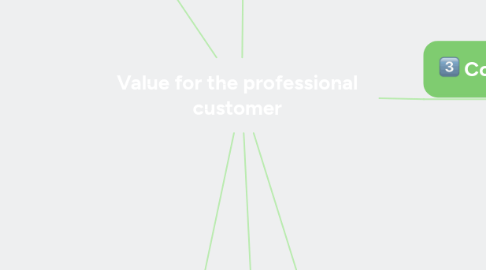
1. Education
1.1. Academy
1.1.1. Keynote speakers with experience
1.1.2. Often scientific substantiated
1.1.3. Seperate starters advice from advanced professionals
1.1.3.1. Basic towards in-depth information and products
1.1.4. Static approach
1.1.4.1. Dynamic is not perceived as a qualitative added value
1.2. Obligated trainings by federation
1.3. Other communication channels
1.3.1. Webinars
1.3.1.1. To listen to again
1.3.1.2. Respect personal agenda
1.3.1.3. No loss of transportation time
1.3.2. Telephone consultation
1.3.2.1. Never a replacement for personal contact, only additional
1.3.2.2. Fixed hours, less flexible
1.3.3. Chatbot
1.3.3.1. Personalazed contact
1.3.3.2. Schedule fit
1.3.3.3. Avoid anwser waiting time
1.4. But lack of time to follow trainings
1.5. Participants
1.5.1. Correct selection on available skills otherwise value destroying
2. Quality
2.1. Product portfolio
2.1.1. 1 company with full protocol solutions
2.1.2. Wide range
2.1.3. Different package composition (pouder, pills, capsules...)
2.1.4. Product differentiators: active forms, additional substances, single and multi combinations
2.2. Confidence in the company
2.2.1. Competence Sales force
2.2.1.1. Personal aprroach
2.2.1.2. Availability
2.2.1.3. Fast response
2.2.1.4. Knowledge and experience
2.2.1.5. Thinking along
2.2.2. Compentence R&D/science department
2.2.2.1. Quality of the in-depth answers
2.2.3. Track record
2.2.4. Marketing material
2.2.4.1. Technical in-depth information
2.2.4.2. Proactive communication
2.2.5. Supplier visits
2.2.5.1. Creates credibiliteit
2.2.5.2. Shows mutual involement and common goals
2.3. Offered security
2.3.1. Certificates
2.3.2. Scientific references
2.3.3. Presence at trade fairs and magazines
3. Sustainability
3.1. Governance
3.1.1. Create credibility
3.1.1.1. Who are the people behind the prodcution
3.1.1.2. Not just in words but in the jar itself
3.1.2. Strict regulations
3.2. Ecological
3.2.1. No heavy metals
3.2.2. No nano particals
3.2.3. Clean/pure products
3.3. Environment
3.3.1. No overfishing
3.3.2. Protection of the biosphere
3.3.3. Supporting local producers
3.3.4. Origin of the products
4. Community
4.1. Sharing of information (B2P and P2P)
4.1.1. Creating a sounding board
4.1.1.1. Exchange experiences on products, materials and methods
4.1.1.2. Tips & tricks
4.1.2. Being a partner towards each other
4.1.3. Who works in my area
4.1.3.1. Find complementary therapist to collaborate with
4.1.4. Through informal groups over what's app
4.2. Make knowledge of Key Opinion Leaders available
4.3. Information
4.3.1. Creating frameworks (protocollen)
4.3.2. Amount of available information
5. Patient
5.1. Reviews on products by professionals
5.2. Confirmation on treatment results
5.2.1. Focus on therapy loyalty
5.2.2. Making the patient understand what is physical and mentally going on
5.3. Products with good taste, size and composition
5.3.1. Anticipate on quality differences
5.4. Lowering barriers for complementary medicine
5.4.1. Show the usefullness and lifestyle need
5.4.2. Use easy to start with products and questionaires to detect needs
5.4.3. Link consumer advice to a professional consultaton
5.4.4. Make it part of your daily habits
5.5. Ease of ordering and delivery
5.5.1. Clear order refering to products and suppliers
6. Price
6.1. Commission base for the professional
6.1.1. Suggestions: bundling prices, start packages
6.1.2. Need for more flexible insights in the oustanding balance
6.1.3. But often education like training is perceived as more important then the discount policy
